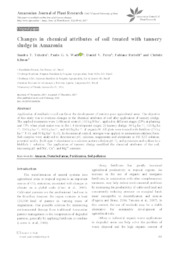Changes in chemical attributes of soil treated with tannery sludge in Amazonia.
Changes in chemical attributes of soil treated with tannery sludge in Amazonia.
Author(s): TEIXEIRA, S. T.; WADT, P. G. S.; PEREZ, D. V.; BERTOTTI, F.; KLIMAS, C.
Summary: Application of residuals to soil can favor the development of nutrient-poor agricultural areas. The objective of this study was to evaluate changes in the chemical attributes of soil after application of tannery sludge. The applied treatments were 1) Mineral control: 100 kg N ha-1 , applied in different stages (25% at planting and 75% when plant maize was in the 1.4 development stage); 2) tannery sludge: 50 kg ha ֿ¹; 100 kg ha ֿ¹; 200 kg ha ֿ¹; 400 kg ha ֿ¹; and 600 kg ha ֿ¹ of organic-N. All plots were treated with fertilizer (75 kg ha ֿ¹ P2O5 and 50 kg ha ֿ¹ K2O). In the mineral control, nitrogen was applied in ammonium sulphate form. Soil samples were analyzed to determinate pH, calcium, magnesium and aluminum in 1M KCl solution, potential acidity (hydrogen + aluminum in a calcium acetate solution pH 7), and potassium and sodium in a Mehlich 1 solution. The application of tannery sludge modified the chemical attributes of the soil, increasing pH and Na+ , Ca+2, and Mg+2 contents.
Publication year: 2017
Types of publication: Journal article
Unit: Embrapa Rondônia
Keywords: Amazon, Disturbed areas, Fertilization, soil pollution
Observation
Some of Embrapa's publications are published as ePub files. To read them, use or download one of the following free software options to your computer or mobile device. Android: Google Play Books; IOS: iBooks; Windows and Linux: Calibre.
Access other publications
Access the Agricultural Research Database (BDPA) to consult Embrapa's full library collection and records.
Visit Embrapa Bookstore to purchase books and other publications sold by Embrapa.

